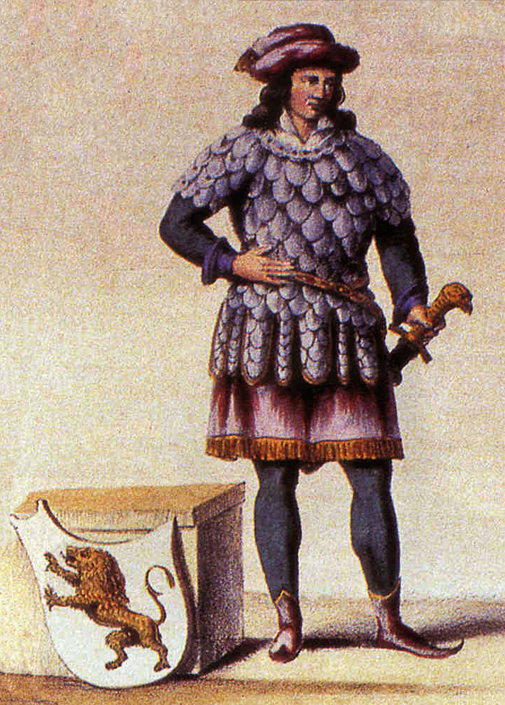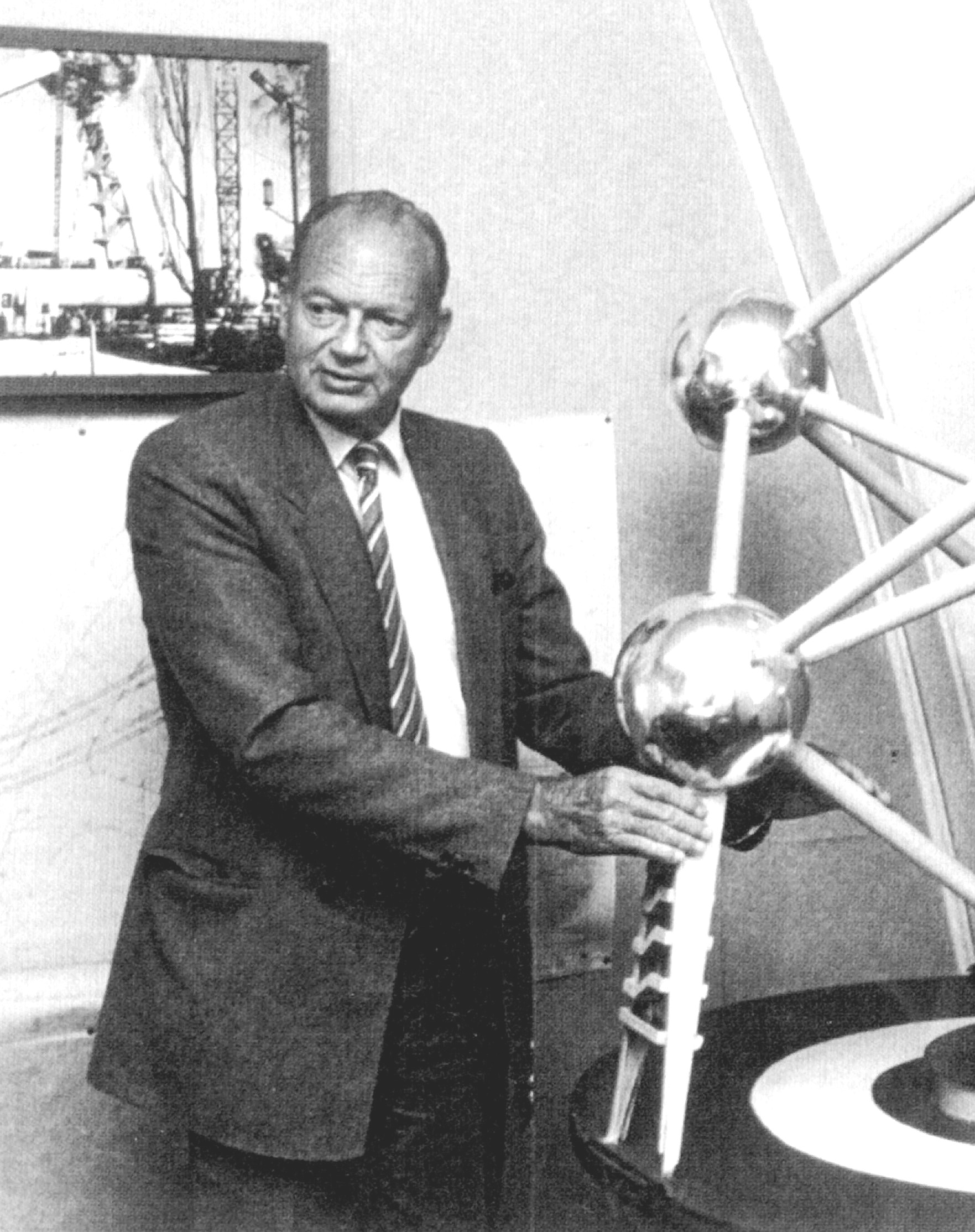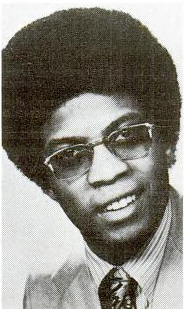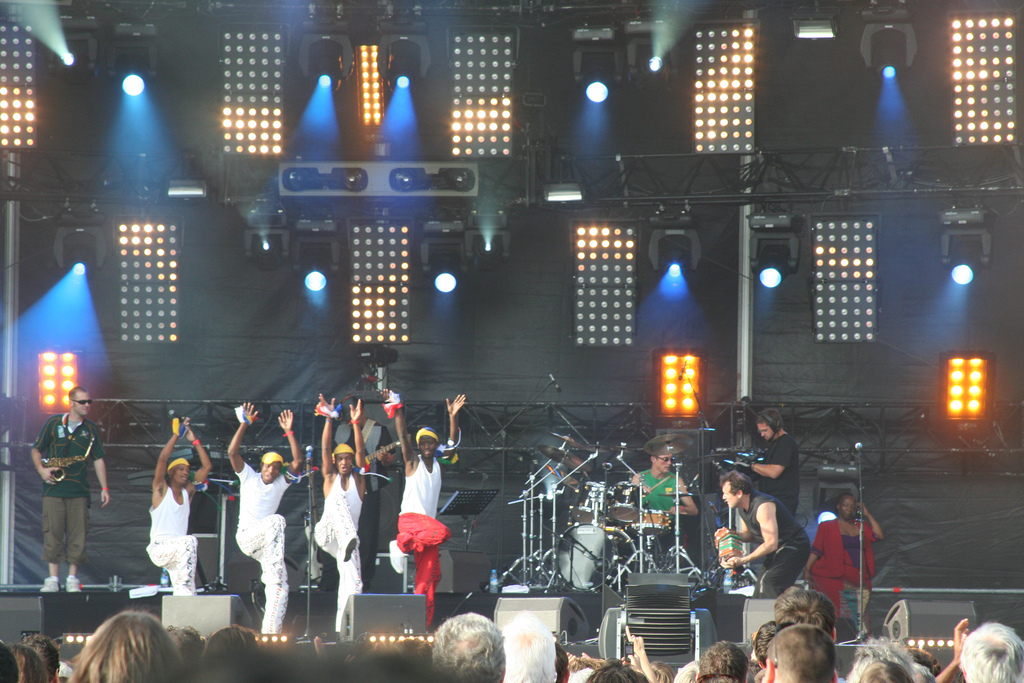|
Couleur Café
Couleur Café Festival is an annual world and urban contemporary music festival taking place around the end of June or early July in Brussels, Belgium. History At its inception in 1990, the festival was organised in the Halles de Schaerbeek/Hallen van Schaarbeek, a cultural centre in the Schaerbeek municipality. In 1994, following work on the Halles de Schaerbeek, the festival moved to the Tour & Taxis site, north-west of the Pentagon (Brussels' city centre). From its 2017 edition, it has been held on the Heysel/Heizel Plateau in northern Brussels, near the Atomium. Description The scope of the three-day festival lies on world music with as main styles funk, hiphop, reggae, dance, dub, soul, Latin, blues and rock divided over four stages. Internationally famous acts as well as less known talent or locally popular musicians are represented. Apart from the music itself, there is also a large art exposition, a market with young designers, dance workshops, cocktail bars and food s ... [...More Info...] [...Related Items...] OR: [Wikipedia] [Google] [Baidu] |
Brussels
Brussels, officially the Brussels-Capital Region, (All text and all but one graphic show the English name as Brussels-Capital Region.) is a Communities, regions and language areas of Belgium#Regions, region of Belgium comprising #Municipalities, 19 municipalities, including the City of Brussels, which is the capital of Belgium. The Brussels-Capital Region is located in the central portion of the country. It is a part of both the French Community of Belgium and the Flemish Community, and is separate from the Flemish Region (Flanders), within which it forms an enclave, and the Walloon Region (Wallonia), located less than to the south. Brussels grew from a small rural settlement on the river Senne (river), Senne to become an important city-region in Europe. Since the end of the Second World War, it has been a major centre for international politics and home to numerous international organisations, politicians, Diplomacy, diplomats and civil servants. Brussels is the ''de facto' ... [...More Info...] [...Related Items...] OR: [Wikipedia] [Google] [Baidu] |
Atomium
The Atomium ( , , ) is a landmark modernist building in Brussels, Belgium, originally constructed as the centrepiece of the 1958 Brussels World's Fair (Expo 58). Designed by the engineer André Waterkeyn and the architects André and Jean Polak as a tribute to scientific progress, as well as to symbolise Belgian engineering skills at the time, it is located on the Heysel/Heizel Plateau in Laeken (northern part of the City of Brussels), where the exhibition took place. It is the city's most popular tourist attraction, and serves as a museum, an art centre and a cultural destination. The Atomium stands tall, making it one of the tallest structures in Belgium. Its nine stainless steel clad spheres are connected in the shape of a unit cell that could represent an iron crystal magnified 165 billion times. Steel tubes connecting the spheres enclose stairs, escalators and a lift (in the central, vertical tube) to allow access to the six visitable spheres, which contain exhibit h ... [...More Info...] [...Related Items...] OR: [Wikipedia] [Google] [Baidu] |
Herbie Hancock
Herbert Jeffrey Hancock (born April 12, 1940) is an American jazz musician, bandleader, and composer. He started his career with trumpeter Donald Byrd's group. Hancock soon joined the Miles Davis Quintet, where he helped to redefine the role of a jazz rhythm section and was one of the primary architects of the post-bop sound. In the 1970s, he experimented with jazz fusion, funk, and electro-funk, electro styles using a wide array of synthesizers and electronics. It was during this time that he released one of his best-known and most influential albums, ''Head Hunters''. Hancock's best-known compositions include "Cantaloupe Island", "Watermelon Man (composition), Watermelon Man", "Maiden Voyage (composition), Maiden Voyage", and "Chameleon (composition), Chameleon", all of which are jazz standards. During the 1980s, he had a hit single with the electronic instrumental "Rockit (song), Rockit", a collaboration with bassist/producer Bill Laswell. Hancock has won an Academy Awards, Ac ... [...More Info...] [...Related Items...] OR: [Wikipedia] [Google] [Baidu] |
Johnny Clegg
Jonathan Paul Clegg, (7 June 195316 July 2019) was a South African musician, singer-songwriter, dancer, anthropologist and Internal resistance to apartheid, anti-apartheid activist. He first performed as part of a duo - ''Johnny & Sipho'' - with Sipho Mchunu which released its first single, Woza Friday in 1976. The two then went on to form the band Juluka which released its debut album in 1979. In 1986, Clegg founded the band Savuka, and also recorded as a solo act, occasionally reuniting with his earlier band partners. Sometimes called ''Le Zoulou Blanc'' (, for "The White Zulu people, Zulu"), he was an important figure in South African popular music and a prominent white figure in the Music in the movement against apartheid, resistance to apartheid, becoming for a period the subject of investigation by the security branch of the South African Police Service, South African Police. His songs mixed English with Zulu language, Zulu lyrics, and also combined working class Music ... [...More Info...] [...Related Items...] OR: [Wikipedia] [Google] [Baidu] |
Manu Dibango
Emmanuel N'Djoké "Manu" Dibango (12 December 1933 – 24 March 2020) was a Cameroonian musician and songwriter who played saxophone and vibraphone. He developed a musical style fusing jazz, funk, and traditional Cameroonian music. His father was a member of the Yabassi ethnic group, while his mother was a Duala. He was best known for his 1972 single " Soul Makossa". The song has been referred to as the most sampled African song in addition Dibango, himself, as the most sampled African musician in history. He died from COVID-19 on 24 March 2020. Early life Emmanuel "Manu" Dibango was born in Douala, Cameroon in 1933. His father, Michel Manfred N'Djoké Dibango, was a civil servant. Son of a farmer, he met his wife travelling by pirogue to her residence, Douala. Emmanuel's mother was a fashion designer, running her own small business. Both her ethnic group, the Douala, and his, the Yabassi, viewed this union of different ethnic groups with some disdain. Dibango had only a ... [...More Info...] [...Related Items...] OR: [Wikipedia] [Google] [Baidu] |
Mahlathini And The Mahotella Queens
Mahlathini and the Mahotella Queens (also known as Mahlathini Nezintombi Zomgqashiyo and Mahlathini and the Girls of Mgqashiyo) were a South African ''mbaqanga'' supergroup made up of the three musical acts linked together by talent scout and record producer Rupert Bopape at the Gallo Recording Company in Johannesburg, South Africa in 1964. The group composed of the following three distinct parts: * The late Simon "Mahlathini" Nkabinde (1937–1999), a "powerful singer" in the ''basso-profundo'' "groaning" style. * The girl group the Mahotella Queens (1964–present), the classic line up being the threesome, Hilda Tloubatla, Nobesuthu Mbadu and Mildred Mangxola. Still recording and performing internationally, the trio are noted for their distinct vocal harmony sound alternating between multi-part harmonies and unison vocals, guitar-led mbaqanga music, and fast stage dancing. * The instrumental band, the Makgona Tsohle Band (1964–1999), that is noted for creating the mbaqang ... [...More Info...] [...Related Items...] OR: [Wikipedia] [Google] [Baidu] |
The Wailers
Bob Marley and the Wailers (previously known as the Wailers and prior to that the Wailing Rudeboys, the Wailing Wailers and the Teenagers) were a Jamaican ska, rocksteady and reggae band. The founding members, in 1963, were Bob Marley (Robert Nesta Marley), Peter Tosh (Winston Hubert McIntosh), and Bunny Wailer (Neville Livingston). During 1970 and 1971, Wailer, Marley and Tosh worked with renowned reggae producers Leslie Kong and Lee "Scratch" Perry. Before signing to Island Records in 1972, the band released four albums. Two additional albums were produced before Tosh and Wailer departed from the band in 1974, citing dissatisfaction with their treatment by the label and ideological disagreements. Marley continued with a new lineup, which included the I-Threes, and went on to release seven more albums. Marley died from cancer in 1981, at which point the group disbanded. The Wailers were a groundbreaking ska and reggae group, noted for songs such as "Simmer Down", "Tren ... [...More Info...] [...Related Items...] OR: [Wikipedia] [Google] [Baidu] |
Mory Kanté
Mory Kanté (29 March 195022 May 2020) was a Guinean vocalist and player of the kora harp. He was best known internationally for his 1987 hit song " Yé ké yé ké", which reached number-one in Belgium, Finland, the Netherlands, and Spain. The album it came from, ''Akwaba Beach'', was the best-selling African record of its time. Early life Kanté was born in Albadaria, French Guinea (a part of French West Africa at the time) on 29 March 1950. His father was El Hadj Djeli Fodé Kanté and his mother, Fatouma Kamissoko, was a singer. They were one of Guinea's best known families of griot (hereditary) musicians. He was of mixed Malian and Guinean descent. After being brought up in the Mandinka griot tradition in Guinea, he was sent to Mali at the age of seven years – where he learned to play the kora, as well as important voice traditions, some of which are necessary to become a griot. As a Muslim, he integrated aspects of Islamic music in his work. Career In 1971 Kan ... [...More Info...] [...Related Items...] OR: [Wikipedia] [Google] [Baidu] |
Zap Mama
Zap Mama is a Belgian singer-songwriter, performer, composer, lyricist, activist, video artist and ethno-vocal therapist born in the Democratic Republic of Congo, raised in Belgium. Zap Mama sings polyphonic and afro-pop music, a harmonic music with a mixture of infused African vocal techniques, urban, hip hop with emphasis on voice. In order to explore and discover the vast world of oral tradition music, she travels throughout Africa, learning, exchanging and sharing information about healing songs, lullabies, mourning, and practising polyphony with griots (bards), Tartit tuareg women, Dogons, Peulhs, Pygmies, Mangbetus, Zulus and others. Zap Mama's worldwide success began with a quintet of polyphonic female singers, whose unique vocal polyphony style has inspired influences in American hip hop, nu-soul, jazz and elements of pop. Her song "Iko-iko" was featured in the film '' Mission: Impossible II''. Sources of Zap Mama's music Sources of Zap Mama's music include Daulne ... [...More Info...] [...Related Items...] OR: [Wikipedia] [Google] [Baidu] |
Papa Wemba
Jules Shungu Wembadio Pene Kikumba (14 June 1949 – 24 April 2016), known professionally as Papa Wemba (), was a Congolese singer and musician who played Congolese rumba, soukous, and ndombolo. Dubbed the "King of Rumba Rock", he was one of the most popular musicians of his time in Africa and played an important role in world music. He was also a fashion icon who popularized the Sape look and style through his musical group Viva la Musica, with whom he performed on stages throughout the world.Margalit Fox (25 April 2016). Musical career Papa Wemba's road to fame and prominence began when he joined the music group Zaiko Langa Langa in 1969. This was followed by his success as a founding member both of Isifi Lokole and then Yoka Lokole,"Both groups used the lokole, a hollow tree trunk played with two sticks, as a rhythmic foundation" along with a short stint as a member of Afrisa International for a few months. During these early stages of his career, he was establishi ... [...More Info...] [...Related Items...] OR: [Wikipedia] [Google] [Baidu] |





